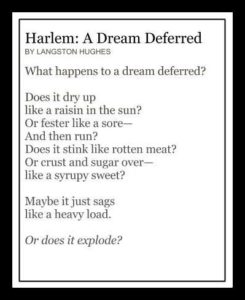
In the poem, “Harlem” by Langston Hughes, the speaker discusses “what happens to a dream deferred” and how a dream postponed can generate consequences. Sharma, K.N. in her essay, “ Harlem by Langston Hughes: Summary and Critical Analysis”, states that the poem “reflects the post-World War II mood of many African Americans”. Therefore, Hughes employs rhetorical questions, diction, and figurative language to produce a feeling of fear and regret as to what might happen if you let a dream die and to draw a connection, specifically to African Americans’ frame of mind after the war.
The speaker commences with the central question, “what happens to a dream deferred” (line 1) and responds to it with rhetorical questions throughout the poem. Depending on the reader, the dream can be anything he/she imagines for herself or others. Sharma, K.N. argues that dream is that of African Americans’ hope “for the right to life. . .and dignified ethnic identity.” Ultimately, she is expressing how Hughes voices that, although, wars and revolutions have passed, spawning an improvement of sorts, the discrimination and lack of rights of African Americans still persist. Regardless of the dream being implied, the speaker conveys that negative outcomes can arise if not realized properly or on time.
In the first rhetorical question asked, “Does it dry up like a raisin in the sun?” (line 2-3), the speaker utilizes simile and argues how a dream undeveloped can go to waste like a dried up raisin which loses its flavor and worth. He then asks, “Or fester like a sore – And then run?” (line 4-5), implying how an unfulfilled dream can hurt and cause pain like a sore on the body, reflecting the emotions African Americans must have felt from a denied dream. Similarly, Sharma, K.N. demonstrates how an unaccomplished dream would, consequently, cause sorrow and despair. In addition, personification is used in line 3 when referring to how a deferred dream “runs”, in order to convey its absence due to the lack of attention granted upon the dream. Lines 6 through 8 continue suggesting the negative aspects of a neglected dream by comparing its diminishing value and purpose to that of rotten meat and crusty syrup. Hughes employs imagery and diction through the words dry, fester, or rotten to allow the reader to visualize the feeling and appearance of a decayed dream and possibly sympathize with the social predicaments African Americans have faced.
The speaker instills a sense of uncertainty within the reader when suggesting, “Maybe it just sags like a heavy load” (lines 9-10), expressing the regret formed from pushing aside a dream, resulting in a state of wonderment for what could have been of a fulfilled dream. Lastly, the last and isolated metaphor, “Or does it explode?” (line 11), brings emphasis to the line, reinforces the theme, and indicates the aftermath of a dismissed dream. Sharma K.N. claims in her essay how this explosion can lead to “the epidemic of frustration that will hurt everyone” because not only will the person who lets his/her dream die, suffer, but so will the people around him/her due to the emotions of regret projected upon them. Therefore, Hughes could be referencing the protests incited from the discriminatory nature surrounding African Americans which affected everyone around, as to impart the repercussions of a denied dream.
Throughout the poem, the speaker warns, or better said, persuades, his audience to never let a dream die in order to prevent unforeseen regret and sorrow, creating a feeling of fear within the reader through the use of diction, metaphor, simile, personification, and imagery. According to the Sharma, K.N., Hughes communicates the poem’s theme from personal experience due to his robbed dream of “life, liberty and happiness” as a result of the discriminatory actions surrounding him as an African American man. Therefore, Hughes argues that a dream shouldn’t be allowed to “dry up” or “rot” when the opportunity to accomplish it is possible.
Works Cited
Hughes, Langston. “Harlem by Langston Hughes.” Poetry Foundation, Poetry Foundation,
www.poetryfoundation.org/poems/46548/harlem.
Sharma, K.N. “Harlem by Langston Hughes: Summary and Critical Analysis.”
BachelorandMaster, 12 Nov. 2013,
bachelorandmaster.com/britishandamericanpoetry/harlem.html.


